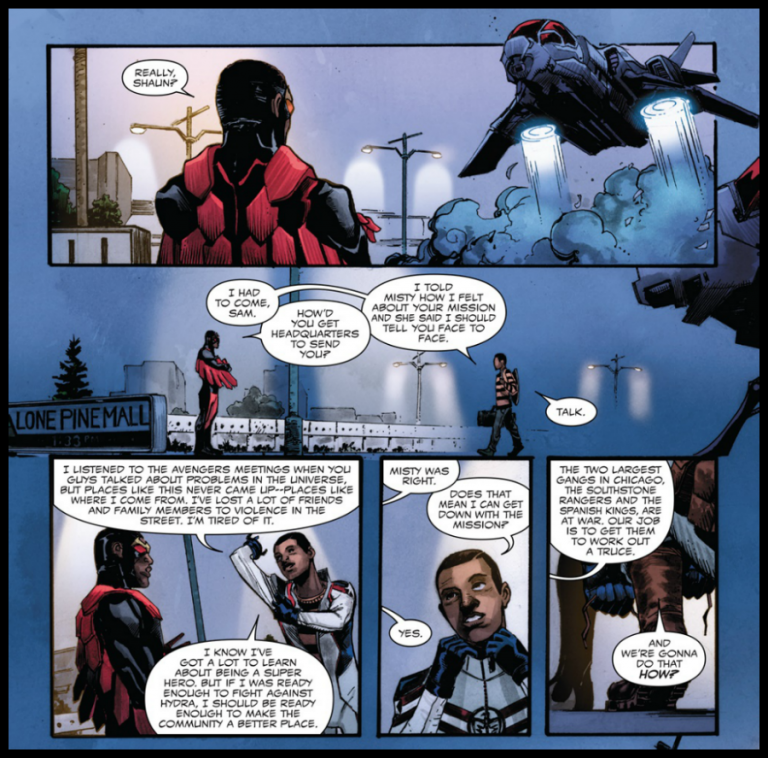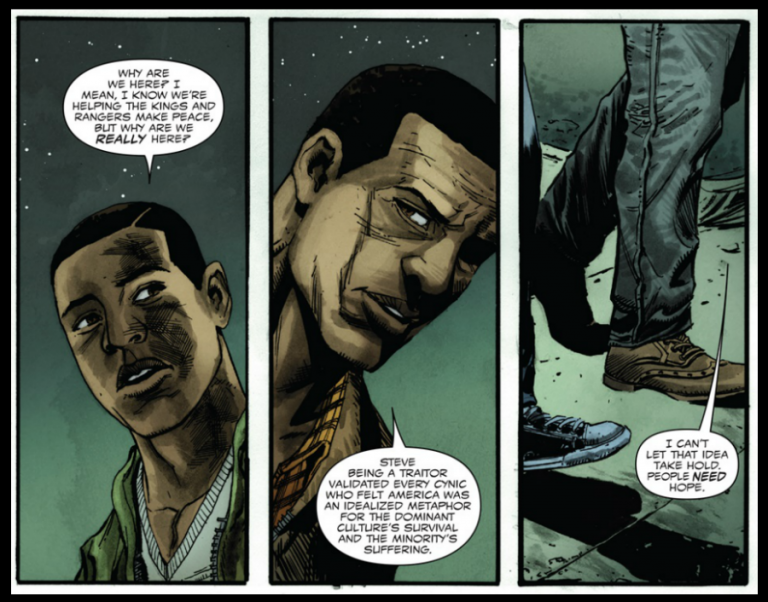By Don Alsafi. Secret Empire is over, and everything is different.
That’s certainly the case for Sam Wilson. While Steve Rogers was busy being an agent of Hydra, Sam carried the shield as a brand-new Captain America. But now Steve is back on the side of good, back in the red, white and blue – and let’s face it, that was always going to happen. Passing on the torch to the next generation is a common trope in superhero comics, but it’s equally true that any decades-old superhero icon will, in time, find themselves back in the role for which audiences have always known them.
But after having been Captain America for the last couple of years… who is Sam Wilson today? What does he stand for – and after all he’s been through, can he still take wing?
Written by Rodney Barnes.
Art by Joshua Cassara.
Colors by Rachelle Rosenberg.
Letters by VC’s Joe Caramagna.
Marvel Primer Pages by Robbie Thompson, Mark Bagley, Andrew Hennessy & Israel Silva.
Fresh voices, mad skills. Writer Rodney Barnes may new to writing comics, but he’s got an impressive résumé as a screenwriter that includes award-winning stints for both The Boondocks and Everybody Hates Chris. Additionally, he’s already dipped his ink in the Marvel well as one of the writers for the Runaways TV show, which premieres next month on Hulu. (The fact that he shares his surname with cap’s original sidekick is simply a fun bonus.)
Despite Falcon being his first ongoing title, however, the strength of his writing is never once in doubt. He puts the economy of a 20-page format to excellent use, packing a satisfying amount of plot, character and theme into every page. What with Sam Wilson leaving the role – and possibly the very idea – of Captain America behind him, he’s understandably in an introspective state of mind, and Barnes conveys this beautifully, without delving into the kind of wishy-washy ambivalence that can often come with such soul-searching. Much of this is conveyed through Barnes’ deft use of dialogue, which is incisive and astonishingly naturalistic.
Illustrating the Falcon’s new path is Joshua Cassara, who is also a somewhat recent addition to comics, having provided the art for a good chunk of Secret Empire, as well as Noel Clarke’s The Troop and Kareem Abdul-Jabbar’s Mycroft Holmes. Despite his few professional credits, however, his pages eschew most of the missteps common to newcomers; his staging ensures that the reader is never confused as to where characters are positioned, and his sense of visual storytelling propels the action from one development to the next in the fewest number of moves, without ever once skipping a crucial beat. The characters are well-drawn and unique, and look remarkably like real people to a degree we don’t often see in comics. (Occasionally Cassara’s gray washes can get muddied underneath Rachelle Rosenberg’s colors, but it works more often than not.)
Head in the clouds, but still grounded. In the wake of Secret Empire, Sam Wilson is reeling and trying to regroup. He’s reevaluating who he is on a number of levels, what this heroing business means to him, and whether the people and ideas he once trusted can ever be believed in again. And yet while Sam may have questions, he’s still proactive, driven and decisive.
Joining him on this new direction is Rayshaun Lucas, the Patriot – in just a few scenes, Barnes introduces Lucas to any readers who may have sat out his debut in Secret Empire, as well as quickly establishing the relationship between the two. Despite the Patriot’s youth, it’s clear to us that Sam doesn’t think any less of Rayshaun due to his inexperience. He’s been a sidekick and a second-stringer himself, after all, and the respect he fully and immediately shows to this new character is something sidekicks aren’t always afforded.
A great illustration of this comes when Rayshaun asks to join Sam on his mission, but is instead told to sit this one out. Unsurprisingly, the kid flies out to argue his case directly – but not in the petulant, overly-eager-to-prove-himself way you might expect. Instead, he lays out his reasons with passion but also with smarts, and at the end of the conversation, Sam tells him to get ready. He may be unsure of a lot – about himself, and what he’s gone through – but he’s not afraid of admitting when he’s wrong.
Black and white and a whole lot of gray. As the book opens, Sam Wilson has come to Chicago, and quickly finds himself trying to broker peace in the midst of a gang war. He meets with the Mayor, who takes credit for Sam’s efforts in public before dismissing and belittling those same efforts in private. He bonds with Rayshaun, telling a story from his youth that gives us not just a deeper look at who Sam Wilson really is, but why he’s at such a crossroads in the wake of Secret Empire. And then, just when it seems like he might get the two gangs to see eye-to-eye, everything goes horribly, awfully wrong.
Make no mistake: While this is a superhero book, and a stunningly character-centric one at that, it’s also a book about race. This is nothing new for the character, of course; one example is the 1983 Falcon miniseries by James Owsley (today known as Christopher Priest), which showed Sam in his professional role as a social worker trying to protect low-income housing residents from their (white) slumlord. And today, he can’t separate the questions he’s asking himself from everything he knows about living as a black man in America. “I took so much heat from my own people—that I was a sellout, a traitor to my race…” Sam confesses. “And where once there was absolute certainty, now, there’s doubt.”
In a multitude of ways, this feels like a very street-level comic, and a well done one at that, which is perhaps what makes the ending so surprising. The final page twist reveals that the day’s events ending in disaster is actually due to the machinations of someone usually seen arrayed against such mystic heroes as Ghost Rider or Doctor Strange. It’s not at all a villain the reader would necessarily expect for the Falcon – but that in itself makes this kind of out-of-nowhere swerve feel particularly exciting.
The bold cover by Jesus Saiz shows Sam as the Falcon, a look of determination on his face as that familiar red, white and blue shield shatters before him. It’s a striking image, and one that’s absolutely emblematic of the mission statement to be found inside. Any readers worried that Sam Wilson might be cast aside can rest easy, as the character has been left in very good hands. Rodney Barnes is the writer you never knew the Falcon needed, and artist Joshua Cassara is clearly a talent to watch.
The question is no longer whether or not the Falcon will take flight once again – but rather to what untold heights he may soar.
9 out of 10
















